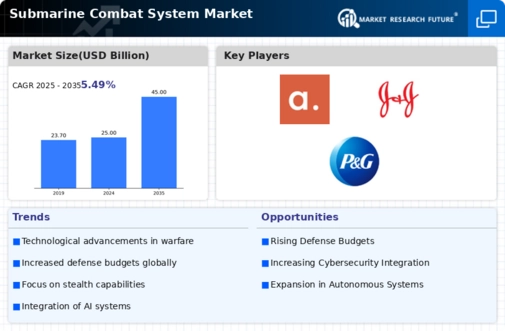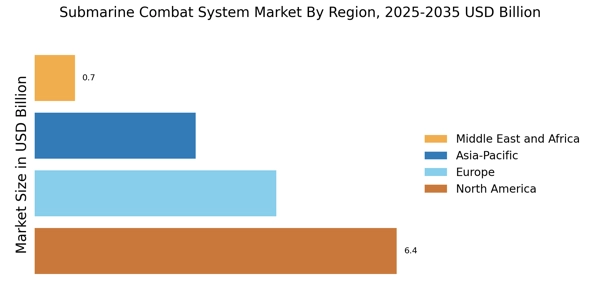Increased Defense Budgets
The Submarine Combat System Market is benefiting from rising defense budgets across various nations. Governments are prioritizing naval capabilities in response to perceived threats, leading to substantial investments in submarine fleets. For example, countries such as India and Australia have announced significant increases in their defense spending, with allocations specifically earmarked for submarine modernization programs. This trend is expected to continue, with defense budgets projected to grow by an average of 3% annually over the next five years. As nations seek to bolster their maritime security, the demand for advanced submarine combat systems is likely to rise, creating lucrative opportunities for manufacturers and suppliers.
Technological Innovations
Technological advancements play a pivotal role in shaping the Submarine Combat System Market. Innovations in sonar systems, weaponry, and stealth technologies are revolutionizing submarine capabilities. The integration of artificial intelligence and machine learning into combat systems is enhancing decision-making processes and operational efficiency. Furthermore, the development of unmanned underwater vehicles (UUVs) is expanding the operational scope of submarines, allowing for more versatile missions. The market is expected to witness a significant uptick in investments in research and development, with an estimated increase of 6% in spending on advanced technologies over the next few years. This focus on innovation is likely to redefine the competitive landscape of the industry.
Focus on Asymmetric Warfare
The evolving nature of warfare is influencing the Submarine Combat System Market, particularly with an emphasis on asymmetric warfare strategies. Submarines are increasingly viewed as essential assets in countering unconventional threats, such as piracy and terrorism. Their stealth capabilities allow for covert operations, making them ideal for missions that require discretion. As nations adapt to these new challenges, the demand for advanced submarine combat systems is expected to grow. Analysts predict a shift in procurement strategies, with an emphasis on acquiring systems that can effectively address asymmetric threats. This shift may lead to increased collaboration between defense contractors and military organizations to develop tailored solutions.
Rising Geopolitical Tensions
The Submarine Combat System Market is experiencing a surge in demand due to escalating geopolitical tensions among nations. Countries are increasingly investing in advanced submarine capabilities to enhance their naval power and deterrence strategies. This trend is particularly evident in regions where territorial disputes are prevalent, prompting nations to modernize their fleets. For instance, the market is projected to grow at a compound annual growth rate of approximately 4.5% over the next five years, driven by the need for enhanced underwater warfare capabilities. As nations seek to assert their dominance, the focus on submarine combat systems becomes paramount, leading to increased procurement and development of sophisticated technologies.
Environmental Considerations and Sustainability
The Submarine Combat System Market is also being shaped by growing environmental concerns and the push for sustainability. As nations become more aware of the ecological impact of military operations, there is a concerted effort to develop submarines that are environmentally friendly. This includes the adoption of alternative energy sources and technologies that minimize the carbon footprint of naval operations. The market is likely to see an increase in demand for submarines equipped with hybrid propulsion systems, which offer reduced emissions. Furthermore, regulatory frameworks are evolving to encourage sustainable practices within the defense sector, potentially influencing procurement decisions in the coming years.


















Leave a Comment